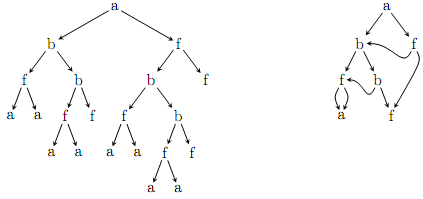当前你的浏览器版本过低,网站已在兼容模式下运行,兼容模式仅提供最小功能支持,网站样式可能显示不正常。
请尽快升级浏览器以体验网站在线编辑、在线运行等功能。
3843:Common Subexpression Elimination
题目描述
Let the set Σ consist of all words composed of 1-4 lower case letters, such as the words "a", "b", "f", "aa", "fun" and "kvqf". Consider expressions according to the grammar with the two rules
E -> f
E -> f(E, E)
for every symbol f ∈ Σ. Any expression can easily be represented as a tree according to its syntax.
For example, the expression "a(b(f(a,a),b(f(a,a),f)),f(b(f(a,a),b(f(a,a),f)),f))" is represented by he tree on the left in the following figure:

Last night you dreamt of a great invention which considerably reduces the size of the representation:
use a graph instead of a tree, to share common subexpressions. For example, the expression above can be represented by the graph on the right in the figure. While the tree contains 21 nodes, the graph just contains 7 nodes.
Since the tree on the left in the figure is also a graph, the representation using graphs is not necessarily unique. Given an expression, find a graph representing the expression with as few nodes as possible!
E -> f(E, E)
for every symbol f ∈ Σ. Any expression can easily be represented as a tree according to its syntax.
For example, the expression "a(b(f(a,a),b(f(a,a),f)),f(b(f(a,a),b(f(a,a),f)),f))" is represented by he tree on the left in the following figure:

Last night you dreamt of a great invention which considerably reduces the size of the representation:
use a graph instead of a tree, to share common subexpressions. For example, the expression above can be represented by the graph on the right in the figure. While the tree contains 21 nodes, the graph just contains 7 nodes.
Since the tree on the left in the figure is also a graph, the representation using graphs is not necessarily unique. Given an expression, find a graph representing the expression with as few nodes as possible!
输入解释
The first line of the input contains the number c (1 <= c <= 200), the number of expressions. Each of the following c lines contains an expression according to the given syntax, without any whitespace.
Its tree representation contains at most 50 000 nodes.
Its tree representation contains at most 50 000 nodes.
输出解释
For each expression, print a single line containing a graph representation with as few nodes as possible.
The graph representation is written down as a string by replacing the appropriate subexpressions with numbers. Each number points to the root node of the subexpression which should be inserted at that position. Nodes are numbered sequentially, starting with 1; this numbering includes just the nodes of the graph (not those which have been replaced by numbers). Numbers must point to nodes written down before (no forward pointers). For our example, we obtain "a(b(f(a,4),b(3,f)),f(2,6))".
The graph representation is written down as a string by replacing the appropriate subexpressions with numbers. Each number points to the root node of the subexpression which should be inserted at that position. Nodes are numbered sequentially, starting with 1; this numbering includes just the nodes of the graph (not those which have been replaced by numbers). Numbers must point to nodes written down before (no forward pointers). For our example, we obtain "a(b(f(a,4),b(3,f)),f(2,6))".
输入样例
3 this(is(a,tiny),tree) a(b(f(a,a),b(f(a,a),f)),f(b(f(a,a),b(f(a,a),f)),f)) z(zz(zzzz(zz,z),zzzz(zz,z)),zzzz(zz(zzzz(zz,z),zzzz(zz,z)),z))
输出样例
this(is(a,tiny),tree) a(b(f(a,4),b(3,f)),f(2,6)) z(zz(zzzz(zz,z),3),zzzz(2,5))
最后修改于 2020-10-29T07:13:25+00:00 由爬虫自动更新
共提交 0 次
通过率 --%
| 时间上限 | 内存上限 |
| 3000 | 65536 |
登陆或注册以提交代码